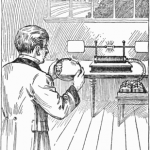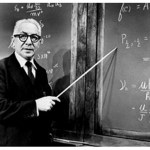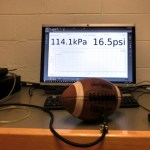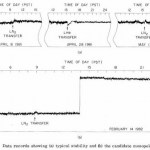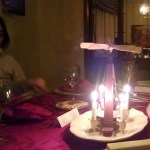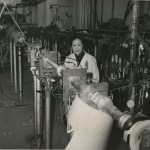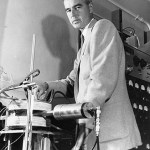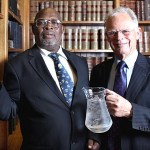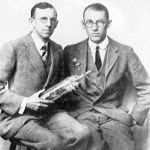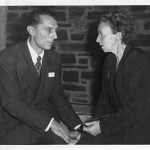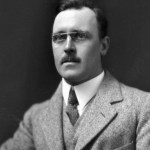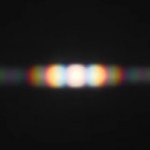Experiment
(When I launched the Advent Calendar of Science Stories series back in December, I had a few things in mind, but wasn't sure I'd get through 24 days. In the end, I had more than enough material, and in fact didn't end up using a few of my original ideas. So I'll do a few additional posts, on an occasional basis, to use up a bit more of the leftover bits from Eureka: Discovering Your Inner Scientist...)
One of the things I was reacting against in writing Eureka is the popular idea of scientists as a sort of unworldly elite, off doing their ivory-tower idealized thing without worrying about…
I wrote up another piece about football for the Conversation, this time drawing on material from Eureka, explaining how great football players are using scientific thinking:
Seattle Seahawks cornerback Richard Sherman gets called a lot of things. He calls himself the greatest cornerback in the NFL (and Seattle fans tend to agree). Sportswriters and some other players call him a loudmouth and a showboater. Fans of other teams call him a lot of things that shouldn’t see print (even on the internet). One thing you’re not likely to hear anyone on ESPN call Sherman, though, is “scientist.”
And…
Over at Curious Wavefunction, Ashutosh Jogalekar offers a list of great surprising results in physics. This is fairly comprehensive, but leaves out one of my favorites, which is the discovery of the muon. Muons are particles like electrons, but a couple hundred times heavier. When they were first detected in cosmic ray traces in 1936, physicists briefly thought they were the mesons that Hideki Yukawa had predicted as the carriers of the strong nuclear force. It quickly became clear, though, that while the mass was about right to be Yukawa's particle, the muon didn't have anything to do with…
I know I said I was done with this story, but this was actually recorded last week: The Daily Planet show on Discovery Channel in Canada contacted me last week when all this deflated-football silliness was exploding, and got a cameraman to come over and record me talking about it. The episode aired Monday night, January 26th, and you can stream it from their archives at the link above (I think it should be episode 216, but when I looked just now, it was just "Episode 16," but the date is correct. My bit is toward the end, starting around the 35:00 mark, but you should totally watch the whole…
The low-level cold I've been nursing for a month now finally exploded into the full unpleasantness of my usual winter illness Saturday, or else I would've been more active following up on my Deflategate article and my ideal gas law post. As it was, for most of the day, I could barely keep on top of clearing comments from moderation.
Anyway, a few things deserve more prominent responses than a comment at the end of a long post, so:
-- I was in bed during the great Bill Belichick press conference, though I saw some mockery of it come across Twitter. While it may not have played well with the…
So, as mentioned yesterday, I got an email asking me about the weird scandal involving the Patriots and underinflated footballs, so I wrote a piece for the Conversation on the subject. since a few people had beaten me to citations of the Ideal Gas Law, though, I decided to bring my own particular set of skills into this, and did an experiment.
[UPDATE: I've added some follow-up/concluding remarks in a separate post from Sunday 1/25. So, if you care about my reaction to Belichick's big press conference, go over there.]
You can see the basic set-up at the link-- I got a couple of footballs from…
One of the cool things about working at Union is that the Communications office gets media requests looking for people to comment on current events, which sometimes get forwarded to me. Yesterday was one of those days, with a request for a scientist to comment on the bizarre sports scandal surrounding the deflated footballs used in the AFC Championship game this past weekend. Which led to me doing an experiment, and writing a short article for The Conversation:
News reports say that 11 of the 12 game balls used by the New England Patriots in their AFC championship game against the…
One of my favorite Christmas presents this year was a Seek Thermal camera to use with my Android phone. This allows for a lot of idle physics-y fun, taking pictures of things in thermal mode.
One idea I had was to do a sort of follow-up to the test of my insulated mug that I did a couple of years ago with a PASCO thermocouple probe. That showed a really dramatic difference between my metal IQC water bottle and the insulated mug, in terms of the rate at which hot water placed in each cooled. So, how do these look in thermal imaging?
Well, I took my insulated mug (actually a different one than…
(When I launched the Advent Calendar of Science Stories series back in December, I had a few things in mind, but wasn't sure I'd get through 24 days. In the end, I had more than enough material, and in fact didn't end up using a few of my original ideas. So I'll do a few additional posts, on an occasional basis, to use up a bit more of the leftover bits from Eureka: Discovering Your Inner Scientist...)
One of the tricky things about writing this book was that I didn't just need stories from the history of science, but stories that fit a particular pattern. The point of the book, after all, is…
One of my Christmas gifts this year was a Seek Thermal camera, so I can continue my transformation into Rhett Allain. What's this for? Why, physics, of course. Such as this video of the operation of the Christmas pyramid my parents picked up in Germany, and had set up at the start of Christmas dinner:
Sadly, the Seek Thermal app doesn't seem to record audio with the video, so you miss out on SteelyKid's running commentary about the whole thing... But you can fairly clearly see the plumes of hot air rising up from the candle to push the vanes of the fan. There's probably a way to estimate the…
For the penultimate advent calendar of science stories post, we'll turn to a great experimentalist with a great biography. This story also appears in Eureka: Discovering your Inner Scientist, but it's too good not to re-use.
Chien-Shiung Wu was born in china in 1912, at right around the time education of women was first legalized. Her father founded a school for girls so he could teach her, then at around the age of 10 she went off to a boarding school, and then the best universities in the country, where she distinguished herself as one of the finest math and physics students in China. At…
One of the very best books I ran across in the process of doing research for Eureka is The Second Creation: Makers of the Revolution in Twentieth-Century Physics by Robert P. Crease and Charles C. Mann. It's an extremely detailed treatment of the development of quantum theory, and includes anecdotes that I haven't seen elsewhere. It also does a fantastic job of showing the essential interplay of experiment and theory through the difficult process of developing quantum field theory, which is often underplayed in popular treatments (which tend to be written by theorists, and often treat…
Another weekend day, another story I'm going to outsource a bit. In this case, to the original scientist, who at the time of his discovery was a 13-year-old schoolboy in Tanzania:
In 1963, when I was in form 3 in Magamba Secondary School, Tanzania, I used to make ice-cream. The boys at the school do this by boiling milk, mixing it with sugar and putting it into the freezing chamber in the refrigerator, after it has first cooled nearly to room temperature. A lot of boys make it and there is a rush to get space in the refrigerator.
One day after buying milk from the local women, I started…
We're going to depart from the chronological ordering again, because it's the weekend and I have to do a bunch of stuff with the kids. Which means I'm in search of a story I can outsource...
In this case, I'm outsourcing to myself-- this is a genuine out-take from Eureka: Discovering Your Inner Scientist, specifically Chapter 2, which tells two stories from the career of Luis Alvarez, who I've talked about before in the context of his experiment to x-ray one of the pyramids at Giza, and the time I wrote him a letter when I was nine about his theory that an asteroid impact killed the dinosaurs…
As I endlessly repeat, I'm an experimentalist by training an inclination, so I especially appreciate stories about experimental science. There's something particularly wonderful about the moment when an experiment clicks together, usually after weeks or months of hard, frustrating work, when things just keep breaking.
Of course, sometimes, breaking stuff can be a Good Thing.
Possibly my favorite story from the development of quantum physics involves just such an occasion, around 1924, when Clinton Davisson and Lester Germer at Bell Labs were trying to characterize a nickel surface by bouncing…
Given that I am relentlessly flogging a book about the universality of the scientific process (Available wherever books are sold! They make excellent winter solstice holiday gifts!), I feel like I ought to try to say something about the latest kerfuffle about the scientific method. This takes the form of an editorial in Nature complaining that Richard Dawid and Sean Carroll among others are calling for discarding traditional ideas about how to test theories. Which is cast as an attempt to overthrow The Scientific Method.
Which, you know, on the one hand is a kind of impossible claim. There…
The winter solstice holidays are a time for family and togetherness, so building off yesterday's post about the great Marie Skłodowska Curie, we'll stay together with her family. Specifically her daughter Irène Joliot-Curie and her husband Frédéric. The Joliot-Curies are possible answers to a number of Nobel Prize trivia questions-- only mother and daughter to win, one of a handful of married couples, etc.-- but the scientific story about them that I find most fascinating is that their Nobel was for the third thing they did that could've earned them the prize, after they just missed out on…
I visited SteelyKid's first-grade class yesterday with several liters of liquid nitrogen. Earlier in the fall, they did a science unit on states of matter-- solid, liquid, gas-- and talked about it in terms of molecules being more spread out, etc. Looking at her homeworks, I said "Oh, damn, if it wasn't the middle of the term, this would be a perfect excuse for liquid nitrogen demos..." I mentioned it to the teacher, though, and she loved the idea of having it in December, as a call-back to earlier science lessons.
It turned out to be weirdly difficult to find assorted round latex balloons…
"You wanted to see me, Herr Professor?"
"Hans! Yes, come in, come in. Just going over the account books. Frightful amount of money going out of this place."
"Well, radium is expensive..."
"Ha! Oh, and speaking of which-- here's one of the sources. Absent-mindedly dropped the fool thing in my pocket last night when I locked up. Terrible habit, I really must work on that. Had a drawer full of the things in Montreal..."
"Thank you. And you wanted to see me about...?"
"Oh, yes. We have a new student, Hans, and I'd like you to put him to work on the gold foil project."
"Shouldn't he have his own…
Scientific controversies aren't always settled by a single dramatic experiment, but it's a lot of fun when they are. It's even more fun when they can be carried out with, as the author put it, "without any other apparatus than is at hand to every one."
I'm speaking in this case of the famous "double slit" experiment of Thomas Young, though if you want to be really picky about it, he didn't originally do it with a double slit, but a single "slip of card" that divided a beam of sunlight. Some distance away from the card, the overlapping light from either side of the card combined to produce a…
